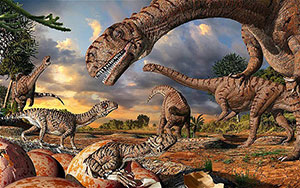
About 230 million years ago, a group of animals called dinosaurs ruled the earth. Dinosaurs were reptiles and most of them hatched from eggs. Some dinosaurs could be as tall as a five-story building, or as small as a chicken like the Microraptor. Dinosaurs had a thick skin covered with scales. The term dinosaur means most fearsome lizard. However, dinosaurs were not lizards, although they could be related to them. Some scientists think that dinosaurs were more closely related to birds. These theories are still being discussed and shows that there is still much we don't know about dinosaurs. Dinosaurs are divided into two groups the 'reptile-hipped and bird-hipped dinosaurs. Paleontologists now have evidence that dinosaurs lived on all of the continents. At the beginning of the age of dinosaurs (during the Triassic Period, about 230 million years ago) the continents were arranged together as a single super-continent called Pangea. During the 165 million years of dinosaur existence this super-continent slowly broke apart and its pieces then spread across the globe. After the dinosaurs died out, nearly 65 million years passed before people appeared on Earth.
Dinosaur Facts
The oldest dinosaurs known are about 230 million years old, and have been found in rocks from Argentina and Brazil. There are references to "dragon" bones being found in China over 2,000 years ago; these bones were probably dinosaur fossils.
The first dinosaur to be named was the Megalosaurus.In 1824 it was named by Reverend William Buckland. Megalosaurus means ‘great lizard’ and it was about 9 metres long, and 3 metres tall.
Jellyfish have been on Earth for over 650 million years, before sharks and dinosaurs.
Dinosaurs lived on Earth for around 165 million years before they became extinct.
Dinosaurs could live to be more than a hundred years old.
The first dinosaur, the Staurikosaurus appeared around 225 or 230 million years ago.
Archaeopteryx was a small creature with feathers that could fly and shows that birds are descended from dinosaurs.
Some dinosaurs had tails up to 45 feet long.
The largest dinosaur was the Brachiosaurus. It is also the largest dinosaur skeleton to be mounted in a museum.
The heaviest dinosaur was also the Brachiosaurus at 80 tonnes. That is about the same as 17 African Elephants. Brachiosaurus was 16m tall and 26m long.
The longest dinosaur was Seismosaurus, which measured over 40 metres, that is as long as five double-decker buses. It was related to diplodocus, which for a long time was thought to be the longest.
The smallest fully-grown dinosaur is the Microraptor recently found in China. It is about 16 inches (40 cm long) and is believed to be a fully grown adult dinosaur. Smaller fossilized examples have been found, but these are of baby dinosaurs. Until the 1990's the smallest dinosaur was thought to be the Compsognathus and it was about the size of a basketball.
There were about 400 - 500 different kinds of dinosaurs in existence.
Time and erosion have erased 99 percent of all dinosaur footprints.
The first dinosaur discovered in North America was made in 1854 by Ferdinand Vandiveer Hayden during his exploration of the Upper Missouri River. He discovered a small collection of teeth which were later described by Joseph Leidy in 1856 as belonging to Trachodon, Troodon, and Deinodon.
One of the most intelligent dinosaurs was the Troodon. It was a hunting dinosaur, about 2 metres long, and had a brain size of a mammal or bird of today, stereoscopic vision, and grasping hands.
The Stegosaurus had a brain the size of a walnut at only 3 centimetres long and weighing 75 grams.
The dinosaur with the longest name was the Micropachycephalosaurus meaning "tiny thick-headed lizard". Its fossils have been found in China, and it was named in 1978 by the Chinese palaeontologist Dong.
Their are over 700 different species of dinosaurs that have been identified and named. However palaeontologists believe that there are many more new and different dinosaur species still to be discovered.
Sources;
http://www.dinodatabase.com/
http://en.wikipedia.org/wiki/Compsognathus
http://www.nhm.ac.uk/nature-online/life/dinosaurs-other-extinct-creatures/index.html
http://en.wikipedia.org/wiki/Dinosaurs
http://www.dinosaurnews.org/
http://pubs.usgs.gov/gip/dinosaurs/